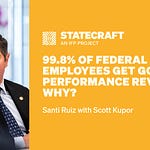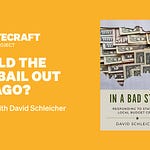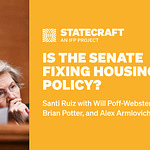This conversation, with transit guru Stephanie Pollack, is one of my favorite conversations we’ve recorded. For one, I had a blast recording — Pollack’s funny, and she’s got a killer Boston accent. For another, she explains some ideas I care about incredibly well — how well-intentioned regulations turn bad, how political pressures make simple things hard to pull off, why building in the real world is so hard. She taught me a huge amount about building transit. And she’s a great storyteller.
For context, Pollack was the deputy administrator of the Federal Highway Administration for the first half of the Biden admin. Before that, she served as secretary of the Massachusetts Department of Transportation (DOT). And a while before that, before she was in the business of building stuff, she was an environmental activist who sued the Massachusetts DOT for building stuff. We get into that evolution in her career here.
This is one of a series of conversations over the coming months about transit: why it’s gotten so hard to build, who fights over it, and what it takes to build something people love.
We discuss:
The difference between federal highway funding and transit funding
Why Pollack changed her mind about suing major transit projects
What went wrong with the Big Dig
How the Green Line Extension was saved
The four Ps of project delays
Thanks to Sofia Scarlat and Emma Hilbert for their audio and transcript edits.
Stephanie, what do most people not understand about Federal Transit?
Most people don't understand that the way transit agencies get money from the federal government is very different from highways — and that fundamentally changes their abilities when delivering a mega-project. Highways can plan in advance because they know how much money is allocated to them every year.
While most state transportation departments are building things, transit agencies are running transit. When they want to do a big project, they have to go through a laborious process, run by the Federal Transit Administration, and essentially get a grant.
Can you explain how much maintenance work transit agencies vs. state highways do?
State highways are 90% building and 10% operating, while transit agencies are 90% operating — pulling off the daily commute — and 10% maintenance. Most people judge their local transit agency based on the morning or afternoon commute, whether the train showed up or broke down.
Transit agencies are operators in their DNA, and highway agencies are constructors.
Is that mostly because it doesn't take that much maintenance to keep a highway running?
It's not that highways don't require maintenance. There are potholes to fill, guardrails to repair, and, in Massachusetts or northern states, snow to plow.
But people think differently about these systems. If you're driving, you don't think, "Traffic was terrible today, that's the state transportation department's fault." But with transit, you think, "Service was awful today, that is the transit agency's fault."
Highway departments could learn from transit agencies about operations, but they're primarily focused on building. The federal government enlisted state highway agencies in the ‘50s, ‘60s, and ‘70s to build the interstate system. People think of the interstate system as federal because it's federally funded, but it's actually built and owned by the states. They were born to build, whereas transit agencies were born to provide service.
Can you explain how state highway agencies get money from the federal government, vs. state and local transit agencies?
State highway agencies don't ask for money, they simply get it. This is called formula funding or apportionment. Every five or six years — the last time was 2021 — Congress passes a bill that lays out how much money each state will get for the next several years. This is mostly for roads and bridges.
Once you have that money, you don't just know what you're getting this year, but also what you’re getting the following few years. The current Federal Highway Bill ends September 2026, but states are already planning projects for 2027 and 2028. They don't legally have that money yet, but, practically speaking, they do. This makes a big difference.
Transit agencies get formula funding too, but it’s for maintenance, not big projects. For major projects, transit agencies must apply for grants and go through a multi-year process before knowing if they'll receive funding. Once they get money for one project, they have to repeat the process for the next project.
Can states use that formula funding for big projects?
The largest transit systems — New York, Chicago, Philadelphia, Boston, San Francisco — cannot use it this way, because the federal government sees its role as supporting their maintenance, not capital projects. Smaller systems that mostly run buses have more flexibility under federal law to move money between operations, maintenance, and capital work.
You've had an interesting career: early on, you were an environmental advocate for the Conservation Law Foundation in Massachusetts. You sued the MBTA over price increases, and were regularly in court with state and local transit agencies.
Later, you end up on the other side of those fights, in the cabinet of [Republican] Massachusetts Governor Charlie Baker. At the State Department of Transportation, you're involved in building out state and local transit, and then you worked on federal highways at the Biden Federal Transit Administration.
What's the through line across your work?
The through line is the importance of transit, not just as transportation, but as the glue holding a region and its economy together. Transit creates access for people who can't afford or realistically use cars.
That's why I sued the MBTA over fare increases that might make transit unaffordable, and sued Massachusetts when they planned highway projects while neglecting transit investment. The constant has been the centrality of transit for metropolitan areas like Boston.
But I think there was a certain amount of naïveté early in my career. I thought, “Well, if they sign a legal document and say they're going to build a project, then they're legally obligated to build the project. And the money part is not my problem. The money part is their problem. They made the promise.”
The more I came to understand the intricacies of the financing system at the state and federal level, the more I understood that the game is actually the money. It doesn't mean anything to say, “We're going to run a world-class transit system,” or “We're going to build this project by this year.” None of that is true if you haven't figured out what you're building, how you're going to build it, and most importantly, how you're going to pay for it.
Give me an example of that intellectual change, or that move from naïveté to “getting it.”
When the Big Dig was planned in Boston, we had all these concerns that it was going to suck up all the money, and there wouldn’t be money left for transit. Massachusetts has two transportation entities: the state transportation department, and the MBTA [Massachusetts Bay Transportation Authority, which operates Boston’s “T” subway system]. Those of us in the environmental world were very clear that we didn’t want the MBTA to pay for transit that was part of this bigger eastern Massachusetts enterprise. We saw the Big Dig as a series of projects, with the transit components as important as highway elements.
We thought that the commonwealth of Massachusetts would be responsible for these transit projects, and it wouldn’t affect the T's budget. That was completely wrong. It's always the T's responsibility to operate the project.
Another example: The Green Line Extension to the T [northwest into Boston suburbs] made the Green Line nearly 5 miles longer. If you try to operate a much longer transit line with the same number of trains, it's going to take way longer for a train to get from the beginning to the end, and you’re going to wait at the platform longer for the next train. So you have to buy trains — I didn’t know that at first. I was just thinking of the extension as its tracks, signals, platforms, right?
So they had to buy 24 new trains, which cost almost $200 million. Now you own 24 new trains. Where are you going take care of those trains? There's all these FTA requirements: they have to be inspected, they have to get upgrades. The MBTA don’t have enough space at their existing maintenance facility at this point: They have a certain size fleet. So now you have to build a new maintenance project.
The cost of the Green Line Extension includes 24 new cars in a brand new maintenance facility: hundreds of millions of dollars. Well, if you take the cost of the project and divide by the number of miles, you'll have a really high cost per mile. But hundreds of millions of that cost aren't to extend the system by 4.7 miles; they're to buy trains and build a maintenance facility. US transit agencies are criticized for spending more than their European or Asian counterparts, but our system is project-driven. In a different country’s system, that’d be in a different part of the budget. The problem for transit in the US is there is no different part of the budget.
Explain the Big Dig to me as if I'm from Arizona and have never heard of it.
The Big Dig was a project proposed by Michael Dukakis when he was Massachusetts governor in the 1980s (1975-1979 and 1983-1991). It involved burying an elevated road running through downtown Boston that separated the city from Boston Harbor. This would improve traffic flow and create a beautiful surface area where people could stroll to the edge of Boston Harbor without navigating beneath a horrible, congested elevated highway.
Officially called the Central Artery Tunnel Project, it became known as the Big Dig after Congressman Barney Frank said he had come to the conclusion that it would be easier to raise the city than lower the central artery.
The Big Dig was initially estimated at $2 billion. What was the final cost?
$12 billion. But that’s if you don’t count the cost of financing it. For some odd reason, we don't include interest on the bonds that get issued to pay for these projects.
it was important because almost every transportation professional in Greater Boston, including some who later worked on the Green Line Extension, cut their teeth on the Big Dig, because it employed virtually everybody. It got a national profile because it ran so far over budget and over time. I told you at the beginning of this conversation that there's always money for highways. The Big Dig was the exception. The feds actually cut the money off and said, “No, the state has to pay for this. This is ridiculous.”
What explains the Big Dig cost overruns, in layman's terms?
It's worth thinking about three different things. One, it's only a cost overrun if the cost you planned for was real. There was never a path to a $2 billion Central Artery tunnel project. There was never a $600 million Green Line Extension.
When people build projects, the cost estimates at the beginning are based on almost no information. The incentive is to lowball the cost. If you tell people “$12 billion” at the beginning, the answer could be no. But if you say, “For only $2 billion you can transform the City of Boston and make traffic go away,” then you have a conversation. Some people would say it's deliberate, some people would say it's what economists call optimism bias, right? But almost anytime you hear about a project that has doubled, tripled, quadrupled, quintupled, it actually — there was never a time it was gonna be built for that price. That price was a fantasy.
The second factor is "scope creep." Once you get some momentum on a project, whether it’s the Big Dig or Green Line Extension or the Second Avenue Subway in New York, people see the money train and they try to get on board. "If you're doing that, can you also fix these nearby roads or bridges? Add parks? Build a bike path?"
So the initial estimate is actually for a project that bears only a passing resemblance to the project that gets built. The project that gets built tends to be bigger, more complicated, and have more elements.
Third, American infrastructure projects move incredibly slowly. The Big Dig permitting began in 1990-91, which is when Massachusetts first discussed building the Green Line Extension. The Green Line got a completion target of 2011 — a 21-year timeframe.
Time is money in construction, especially when you start without full funding. When you start a project, you don't put out one big contract to build the project; you actually put out a contract for the money you have. “It's a $2 billion contract. I only have $600 million this year. I'll put a $600 million contract out. We'll start to do some preliminary work. Then at the end of that contract, I'll go procure a new contract, maybe hire a different company depending on who bids.”
The first company will be paid to take down all the stuff that they're no longer using. The new company will be paid to “mobilize,” to put up new stuff. Building projects in this series over a long time, because we don't have enough money at the beginning, is really toxic to delivering projects on budget. But it's how we've gotten in the habit of building things in this country over the last decades.
How does inflation affect this, while the real value is being eaten away over time?
Before COVID, and during most of the growth in the federally funded infrastructure program — the interstates and transit systems of the ‘80s, ‘90s, and ‘00s — we had four decades of low inflation.
But because of COVID and inflation, at one recent point, the tracking measure the Federal Highway Administration uses to measure construction cost inflation grew at 2% monthly. If you delayed a project five months for a community process or a permit or procurement, you increased the cost of the project 10%. Now you don't have enough money for the project, so you go and you find more money for the project, which takes you months, during which time the cost of the project goes up.
In an atmosphere of 1-2% per month construction cost inflation, you can't build projects the way you built them before. Except we still do.
What factors lead to extended project timelines?
I find it helpful to think about 4 Ps: planning, permitting, public engagement, and procurement.
It’s not a bad thing to spend a long time planning. There's an argument to spend more time planning, and then go fast once you get started. But we can plan forever, and this is particularly true for projects for which we don't have enough money. If you're an elected official who supports that project, you create some sense of momentum by having planning meetings and issuing documents and doing PowerPoints and little events.
Consider South Coast Rail in Massachusetts — when we held a groundbreaking ceremony, the state senator said, "This is my fifth groundbreaking for this project." Because previous governors had found some money and done a little piece of work.
And if I can't get the state legislature to pony up enough money in a given year, all I can really do is planning, right? That's the only thing that fits the scope.
Right. Planning and permitting, as frustrating and lengthy as they can be, they're gonna be 10-20% of your project costs. Most of your project costs are going to be from building the project. If you have short money, it’s a great thing to do. Then planning is followed by permitting, which unquestionably takes too long and is too complicated in this country.
The third P, public engagement, matters tremendously. Users and affected communities deserve input. The problem is, these three processes can continue forever. You've heard people call it the vetocracy, and the processes are a real pro. And what I say is the processes are a real problem. Okay? But the actual problem is that no one is willing to make a decision and find the money. Until someone is willing to make a decision — either yes we're building it and I can tell you how we’ll pay for it, or no we're not — then planning and permitting and public engagement can go on and on for decades. Then, when people look backwards, they say, “Oh, the planning, permitting and public engagement is why it took decades,” as opposed to the unwillingness to make a go/no-go decision.
But really, the lack of money is why it took decades, and during those decades, we did a lot of planning, permitting, and public engagement to keep the project alive.
It's an interesting point that while you're waiting for the political will, these processes can just drag out forever, because there’s nothing else to do.
And to be clear, there's value. You are advancing the project. Sometimes if you're creative, you find little pieces of money, and you fix some utilities that are in the way, or you fix a bridge that will need to carry train tracks. Or you fix a place where the road and train tracks meet, and if you fix 5 crossings a year for five years, then 25 grade crossings are done, and then they don't have to be part of the project.
I don't want to suggest planning, permitting, and public engagement are wasteful — they're not. But the value they add to a project is small relative to what you could get with a more succinct process.
The fourth P is procurement — the legal process for hiring builders. It's less discussed but crucial. Procurement adds time but also value. With the right team and contract structure, your chances of successful delivery improve dramatically. If you get procurement wrong, you're starting off in the wrong place and you haven't even begun building the project.
Talk me through the Big Dig in a little more detail. How did each of those Ps factor in?
Planning took a while, because at first the Big Dig was a combination of two road projects that were separate: One was to bury this elevated highway through the center of Boston. A second was to build another tunnel under Boston Harbor to connect Logan Airport to metropolitan Boston. The decision was made by Governor Dukakis and his transportation secretary, Fred Salvucci, to put those two together. That probably created political momentum to get it done, but a planning process that starts with two big projects and combines 'em into one gigantic process takes a long time.
That’s the first P, planning. Now, permitting: a lot of people talk about NEPA or the National Environmental Policy Act as permitting, and it is important.
I talk a lot about NEPA.
I've done probably more NEPA than anyone: I've written comments, I've sued people under NEPA, I've signed records of decision in my role as Federal Highway Administrator under NEPA. One of the problems with permitting processes is that they are sequential instead of concurrent. We do them one after another instead of at the same time. If you think about it, there’s no reason you couldn't do planning and public engagement and permitting at the same time. But in the US, permitting is very non-sequential.
The idea of NEPA was to gather a lot of information, give the public a chance to look at it, and use that information to better define your project, to identify what is usually referred to as the “locally preferred alternative.” Having finished that information gathering part of the process, then you move into actual permits. You need a permit to move utilities, to fill in part of a river, to build on part of a park, etc. Those permits can be federal, state, and local, and finishing NEPA is just the starting gun for the rest of permitting. People think it’s the finish line. It’s the starting line.
I want to ask this carefully, but how has your view on the ability to litigate under NEPA changed since you went from litigating to defending against litigation?
The fact that you can litigate under NEPA is essential. If your concern is that agencies will not do their job and that they need to be held accountable. If you let them screw up the process and then they can still move on and permit and procure and build the project, that's a terrible thing.
But once you subject that decision at the end of NEPA to litigation, it changes everyone's behavior throughout the entire process because everybody is thinking about the lawsuit. The NEPA process at this point is about minimizing the risk of a lawsuit, or covering your butt if there's going to be a lawsuit or creating the factual record.
I'm a big supporter of intelligent de-proceduralization, but if you make the process really quick and dirty and short, and they can still litigate the result of that process, I'm not sure that it just doesn't turn into the next NEPA.
I want to say something else about NEPA that we didn't know when it was passed, or even in the ‘80s. I speak as someone who literally wrote their third year law school paper about NEPA. Abundance types, people like Jen Pahlka, we don't like “waterfall” decision making, right? We like test-and-learn decision making. We like the government to be able to do a little bit, learn something and then do a little bit more.
Well, NEPA is the ultimate waterfall. You literally have to do this whole multi-year process before you can do anything. It assumes that when you build a big project, like the Big Dig or the Green Line Extension, that you literally know everything about the project, to the point where you can calculate exactly how many square feet of wetland you're going to impact.
But let’s say you change the project because you discovered environmental impact, or because public engagement convinces you to. Every time you change it, it cascades, and it changes all of the impacts, right? If you just set aside NEPA and you just ask yourself what a rational process would look like, it would actually be iterative. It wouldn't be waterfall. You'd start with a project, you'd engage the public, you'd start to look at the environmental impacts, you'd start to think about the permitting requirements, then you'd make changes to the project, which would in turn change your permitting and change your impacts.
But until two decades ago, the one way you procured a team to build infrastructure for you was called “design-bid-build.” Here’s what that meant: the agency that owned the road or bridge would design every asset, even if it took them 25 years to design it. They would design it so specifically that it could be permitted, and then they would write a procurement that said, “Build exactly this, this way.” That would be the first time they actually knew what it really cost, because now a real company is trying to build it.
Then they would go out and build that exact project. Except of course they wouldn't, because as soon as you started building it, you'd bump into something you didn't know was there. Something we've learned is that “design-bid-build” is a really stupid way to build a project.
A better way to build a project is to actually engage the team that's going to help you build it earlier in the process. The best infrastructure projects being built in the US and around the world right now are not “design-bid-build” anymore. But nobody has really taken that step backwards and said, “How should that change how we permit things and do public engagement and plan things?” If the thing that you're doing is not done at a moment in time, but a thing that is iteratively being planned and designed and permitted and thought about and engaged with the public right up until the date it opens.
Move us forward in time to the Green Line Extension, in which you're no longer litigating these projects from the outside — you’re responsible for executing them. Again, imagine I’m from Arizona. I’ve got no special knowledge of Boston geography. What is the Green Line Extension, and at what point do you come into that whole project?
The Green Line is a light rail line in Boston. It’s a subway line — part of the time it’s underground, and part of the time it’s a trolley that runs down the middle of streets. It runs from Boston over the Charles River, has a couple stops in Cambridge, and then ends just before a city called Somerville.
To understand why the Green Line Extension matters so much, you have to understand Somerville. Somerville is a four-square-mile city with 80,000 residents: one of the densest places in the Northeast, and it has no transit except buses.
The idea of the Green Line Extension seems really simple. There’s a commuter rail line from the North Shore of Boston that runs through the city of Somerville on tracks that are already owned by the MBTA, without stopping. So you're in Somerville, you have terrible transit, you rely on buses, and you watch these commuter trains full of people from distant suburbs go through your city. They’re diesel trains, so they’re spewing diesel exhaust into your city. And you get no service.
And you're one of the densest places around for hundreds of miles.
Exactly. Clearly you can support transit use. So someone asked the logical question: What if you extended the Green Line from where it currently ends, at a station called Lechmere, and you just extended it? Then boom, the Green Line hits this existing commuter rail line. You run a second set of tracks next to the existing line. You now have six new stations in the city of Somerville, and now 80% of the city is within walking distance instead of 20%.
The Green Line Extension starts as a really easy project. It’s going to cost a few hundred million dollars, but the Big Dig is going to cost a few billion, so you just sort of attach them together and say, “That’ll work.”
Except for one thing. It probably occurs to you that if train tracks run through a busy city, people are going to be crossing those tracks every day. So you build bridges over the train tracks. Bridges are held up by things called abutments. Where do you put the abutments? When the original commuter line was built, of course they were put right next to the train tracks. They didn’t leave enough room to put in a second set of train tracks. But now that they’re putting in a second set of tracks, eight bridges have to be completely rebuilt.
Somehow, this was never part of the conversation. It wasn’t part of the cost estimates.
Back up for a second. How is it that you have a bunch of smart people thinking about transit, and nobody thinks about this?
I mean, I’m sure somebody thought about it. But the public image was: this is a no-brainer. We’re just going to put one set of tracks next to another set of tracks. They didn’t think about bridge abutments.
Also, there’s this other question. Somerville is up here [gestures with hands] and the train tracks are down here [gestures]. If the commuter rail doesn’t stop in your city, you don’t need a station. But if you want six stations along a less-than-five-mile route — because the whole point is to get everybody within walking distance of a stop — then where do the stations go? Do you need elevators? You have to accommodate people in wheelchairs, people with strollers.
So one of the reasons that projects cost a lot more than people think is: they were never going to cost what people said at the beginning. This project was never going to cost less than a billion dollars. The problem was that people spent many years believing they knew what it would cost.
Fast forward to 2015: at that point, it had gone through the NEPA process. It had gone through this huge process through the FTA to figure out what it would cost. FTA said, “It’s going to cost $1.9 billion. We’re going to give you half of that. The state of Massachusetts will pay the other half.” They sign this agreement in January of 2015. This is a project that’s been in planning, permitting, and public engagement since 1990. So now, 25 years in—
You’re finally ready to go.
And they used this new procurement method that had never been used before in Massachusetts — probably without really understanding it. You pick the person who’s going to build your project, and then you let them tell you how much each subsequent contract is going to cost. Rather than putting the contract out and letting five people bid on it, you pick the team, and then you say, “What’s this going to cost?”
Now why would you do that?
Because it moves faster, and because all major infrastructure projects occur in the real world, with real politics. Deval Patrick is the governor of Massachusetts, and Barack Obama is the president of the United States, and Donald Trump is running against Hillary Clinton, and a strong Republican is running to succeed Deval Patrick.
The project is being designed so that they can secure a “Full Funding Grant Agreement” — the legally binding agreement in which the Federal Transit Administration promises you your billion dollars — while Obama is still president and Patrick is still governor. When they work backwards from that date, they come to the conclusion: this particular procurement method will get you there. No other procurement method will.
Just to make sure I’m hearing you correctly: the political goal is to get the contract done and the money obligated before there are any major changes in administration, either at the state or federal level?
Get it paid for. Because remember, one of the things that kills projects is that at the beginning, you don’t know where all the money is coming from. It’s not a bad idea to institute a process where your goal is to have all the money at the beginning. That actually is a good thing. There’s this little political window in which you could have all $2 billion that you need to build the project — from the get-go. But it requires you to do procurement in a way you’ve never done before.
What are the consequences of doing procurement that way?
They start to give small contracts, mostly for design, to this consortium they’ve hired. The first project costs way more than they thought it would. The second one does. The third one does. The fourth one does. And the fifth one does.
Then Deval Patrick leaves office and Gov. Charlie Baker comes in. The next package comes in: it’s the first big construction package. It’s to rebuild one station, the one you have to move to connect the Green Line to the commuter rail line, and to build the next two stations. What we thought was a $2.2 billion project becomes a $3 billion project: and that’s assuming the following three packages don’t also come in over.
I’m Secretary, it’s 2015, and earlier that year, we had four blizzards in a row: One hundred and fourteen inches of snow, and the T shut down in the middle of a weekday. “Snowpocalypse.” The general manager quits. The legislature, with the Governor’s strong support, puts the T under a Fiscal and Management Control Board, like New York City in the 1970s.
Now I’ve got to go to the Control Board and tell them — Oh, and by the way: the federal money is fixed. You get a billion dollars toward your $2 billion project. You also get a billion dollars toward your $3 billion project — or your $4 billion project. All the cost overruns? They’re on the T.
But the T doesn’t have the money, and even if the T had the money, it’s a valid question for the Governor and the Control Board to ask: Would you spend it on the Green Line Extension? Or would you fix all the things that we have discovered are wrong with the T as a result of Snowpocalypse?
In the summer of 2015, it becomes impossible to ignore: this project does not cost what we thought it would cost. And the Federal Transit Administration says, “We’re going to freeze the money we did give you, because we want to understand what the heck is going on here.”
Let me jump in. You’re Secretary of the state’s Department of Transportation at this point. Who are the different voices in your ear? What pressures are you under?
This is a project I know well: I sued over it ten years earlier. It’s also a project I believe in, because before I became Secretary, I was doing a ton of work on getting housing built near transit. Somerville had done that, to its credit, and completely re-planned and rezoned itself to bring in denser housing development around those six new stations. They believe that this project will support 10,000 new housing units and new riders. I want to build this project.
But this is who you need to convince:
You need to convince the Governor, because this is going to be state money.
You need to convince the Control Board that, of all the things they’re facing, they’re going to peel off hundreds of millions that they weren’t planning on spending and put it into this.
You need to convince the local elected officials in Cambridge and Somerville, who are expecting the project to be the project they were promised for 25 years.
You actually need to convince the legislature — because at the end of the day, most of the new money is going to come in the form of state bonds or some other form of state money.
And you actually need to convince the Federal Transit Administration that what we’re building is close enough to the project they approved. Because there is a new President, and if the administration wants to freeze the grant — something we didn’t think about as much in 2015 — they legitimately can.
If we say, “We’re not going to build seven stations, we’re just going to build the first three — that’s how we’re going to save money,” they could say, “Well, we didn’t give you a billion dollars to build three stations. We gave you a billion dollars to build seven. You don’t get the billion.” So we had to keep the billion we had in state money, and figure out how to build the rest of the project.
Okay, you’ve got a lot of cross-pressures, stakeholders. What do you do?
We try to do project development fast instead of slow, because time is not on our side at this point. We either have to sort this out, have a new project, and get going again, or the governor’s gonna say no. Canceling it is on the table. I honestly believe if the governor hadn’t said, “Canceling this project is on the table,” we would’ve never gotten the political alignment. People had to believe that there was a real risk, and a clock ticking.
So we say, “Six months from now, I would like a go/no-go decision.” That means permitting, planning, public engagement, and procurement all have to happen from where we are. We can’t afford to have a new project six months later in which we’re still asking: “Do we need a vote of the city council? Do we need new permits? Do we need new dollars? Do we need a new procurement?”
In fact, it was easier for me, in some ways. When I-95 burns down in Philadelphia, people say, “Isn’t it amazing that overnight we can do something that usually takes years?” Secretary Duffy just said this about I-40 in North Carolina. This is a different kind of emergency, but it’s the same thing — you just have to throw out the business-as-usual mindset inside your own agencies and say, “We’re not gonna do it that way. We are going to simultaneously process this.”
We needed a different project team. I didn’t believe anything anyone said: I didn’t believe the engineers, the cost estimators. And the governor, legislature, and Control Board wouldn’t either, because they had been wrong for so long.
We announced the reset in August, hired the new team in January, and we promised people an answer by May. We actually fired all of the old teams so that we were in a position to do a new procurement, we figured out the procurement strategy, we re-engineered the project, and we figured out the financing — all of it — basically between December 2015 and May 2016.
Tell me about the redesigns. What changed about the actual project?
I live on the other end of the Green Line, the western end. When you walk to a Green Line station in my town, it’s like walking to a slab of asphalt. There’s no station, no fare gate, no heat, no rain protection. You just stand there and wait for the train to come.
They had designed beautiful stations — $50, $60, $70 million stations. But if the stations cost $5 million instead of $50 million apiece, and there are six of them, that’s hundreds of millions of dollars. It’s pretty easy math.
So what do you hold constant? You have to know what you're aiming at. We said two things. One: it’s got to cost hundreds of millions of dollars less. It wasn’t like, “Oh, if you save 3%, we’re going to clap and go ask the legislature for the money.” We had to shave hundreds of millions off the cost.
And two: same amount of service. If transit isn’t frequent and reliable, people don’t ride it. It doesn’t matter how nice the station is if the service isn’t frequent and reliable. You can’t eliminate a station. You can’t eliminate the purchase of the 24 new cars, because you need them to run the trains frequently. We held some things constant, and that meant the team, the public, and the elected officials could focus. I’m not saying it’s easy, but it’s a lot easier.
How did you manage risks on this project?
Project delivery is risk management, but many project delivery teams are not about reducing risk. They’re actually about playing a game of hot potato with risk. “You take it.” “No, you take it.” “No, you take it.” You don’t fix anything by doing that. It’s just about who gets stuck holding the hot potato when the risk blows up.
During the reset, we asked ourselves: What are the biggest risks with the project? Which ones could we actually fix before we put it out to bid again? One of the biggest risks was that you had to build it right next to an operating commuter rail line. We operate the commuter rail line, and those tracks needed to be moved over a little to make room. We could do that beforehand and not put it in the contract for the new team building it. That way, when they bid the new project, the risk — like not being able to move the tracks, or not getting permission because it's a busy time of year, or because the Patriots won the Super Bowl and we need to have a parade and can’t shut down the commuter rail — wouldn’t be theirs to manage.
People tend to try to keep risk constant, and they do one of two things: They either try to turf it off onto other people, or they build in what’s called “contingency.” You just say in the budget, “Well, we’ll throw $300 million in, just in case something bad happens.” And because it’s already in the budget, it doesn’t look like the budget goes up.
The problem with that — and I don’t mean to speak ill of the engineering world, but I believe this is true — is that if there’s hundreds of millions of dollars sitting in the budget, you will find a way to make the case that you should be given that money to do the work you're doing.
It’s staring you in the face.
The FTA actually has a process for thinking about risk that involves increasing the amount of contingency money for these big transit projects. I’ve come to the conclusion that it’s not actually de-risking any of these projects. It’s just creating a giant bulls-eye for the builders.
We wanted a smaller contingency amount that was very, very tightly controlled. That’s another place we saved money: We just said, “We’re really going to build this.”
And you gave yourself less rope.
Because you hang yourself when you give yourself too much rope.
Long story short, we fired the old contractors, we hired a new team, we went through a public process. We saved money through much less elaborate stations, downsizing the maintenance facility a bit. But we kept the 24 trains, we kept all seven stations, we cut the contingency, and we designed a different kind of procurement that addressed risk.
We started doing work while we were doing this other process, and the work was chosen specifically to reduce risk. I spent an immense amount of time with the mayors of Somerville and Cambridge, convincing them to kick in some money. In the end, the Control Board set a “not-to-exceed price.” They said, “We will vote to put it back out to bid, but if the bid comes in over this number, we’re telling you right now — we’re not approving it.” That told the world: don’t even bother to prepare a bid package unless you’re coming in below that number.
One other controversial thing: there was a beautiful community path for walking and biking that paralleled the entire Green Line Extension. Where we got in the most trouble was where there was room for the Green Line, but not enough room for the bike path. It turned into an extremely expensive bike path, because you had to do really expensive things to make it work, like moving transformers out of the way.
We said we were willing to build it with a non-continuous bike path. “We’re not going to take it all out — we’re just going to take out the really expensive parts, and those will be on city streets.” I mean, people bike on city streets. I do. But people hated it.
Our obsession with procurement served us well here. There were four things that we could not figure out how to pay for, the most important of which was this community path. We came up with the following idea: we were going to bid it out, and we already knew what the highest price was going to be. It was going to be $1 below what the Control Board said they were willing to spend.
So we set up the competition very differently. It was complicated, but it allowed us to pick a team we liked. But we also said: “The bidder who can figure out how to pay for the most of those four things, and still come in under the price, will win.” The winning team figured out how to pay for all four — including the community path — for less than the amount the Control Board said they would pay, because we let the private sector figure out the solution, instead of designing it to 100% and then asking what it would cost.
This goes against every ounce of culture inside the MBTA. You don’t just go to the world and say, “World — tell us how you would do this project.” You tell the world, “We’re the MBTA. We know more than anybody. We are telling you what needs to be built, down to every last detail. You tell us what it costs.”
That’s the culture. And it is painful, but going another way got us a $2.3 billion project, which at the end of the day ended up being more than the $2.1 billion, but not by so much that we couldn’t live with it. That’s pretty much what the project came in at, when it was done.
Last question: You're a Democrat who worked very comfortably with a Republican Massachusetts governor. If you were advising Secretary Duffy now at the Federal Transit Administration, what advice would you give him, based on everything you just told me about what we’re doing wrong?
Secretary Duffy testified before Congress recently, and he said that as he looks ahead to the next five-year bill — the one that lays out all the money for the state transportation agencies, called the Surface Transportation Reauthorization — his priority is safety, which is hard to disagree with, especially when a plane crashes on your first day on the job.
But after safety, his priorities are permitting reform and project delivery. I would say to Secretary Duffy: if you are serious about that, then be serious about really changing things up. When we fix processes in government, we tend to leave all the existing processes in place — and then we add the fixes on top of them. You just get an even more complex system.
Now, I understand why. Politically, it’s very hard to take things away. Everything that’s there is there for a reason. Every word that’s in the regulations is there because someone cared about that word, that permit, that process, that meaning, that step in the planning process.
But honestly, we have built a system that makes it extremely difficult for anybody to deliver a federally funded project. We’ve gotten to the point — and I had these conversations both when I was running state transit and when I was at Federal Highway — where state officials will look at a highway project for which they could get federal money, and they will choose not to use federal money. It complicates the process so much that they’d rather go fight with their legislature and governor to get state funding.
When we’ve built a system where people are willing to walk away from federal funding because of how hard it is to use—that should be a giant flashing sign that we need to dismantle or at least re-evaluate the whole thing. Not just make little fixes at the edges.
I am a naive person, and an optimistic person. I still don’t think this is a Republican or Democratic issue. Whatever it is you want, you should care that it can get built with the smallest amount of taxpayer dollars, in the shortest amount of time. Then you can fight about which kinds of projects you're willing to fund. That’s political.
Again, we can’t take all the rules away. Some of them exist because people would’ve hired their brother-in-law and handed them the contract. That’s the Mark Dunkelman issue, and the progressives are right about that.
But if you are serious when you say: we need to fix permitting, and we need to fix project delivery, and we need to make sure we can efficiently build the things people need with the money the government has — then it’s not a little fix. It’s: Why can’t this look more like rebuilding I-95? Or Interstate 40? Or the first six months of how we did the Green Line Extension?
Why does it have to take so long? It’s no one’s fault. Every single person who put any one of those requirements in place meant well. But we have just added so many, over so many decades, that we are now working at cross purposes to the fundamental objective: To build the things people need, in a reasonable amount of time, and at a reasonable cost.















